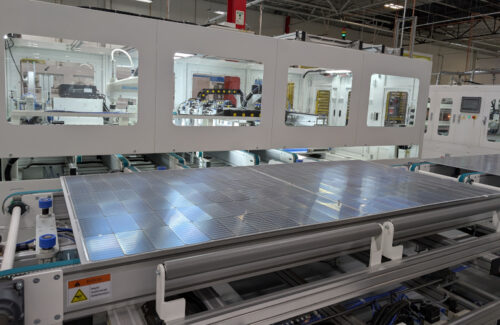Passing the Inflation Reduction Act was the starting gun for the race to build up the domestic supply chain for the solar and storage industries. The Advanced Manufacturing Production Credit (45X) offers incentives to American companies making solar panels, inverters, energy storage systems, tracking components and more, and it set off a resurgence of manufacturing at home. Not only were more companies incentivized to make product domestically, but they could sell those credits for up-front cash to invest in their operations, something that many companies have taken advantage of.

Manufacturing at Boviet Solar’s North Carolina solar panel assembly site. Credit: SPW
The One Big Beautiful Bill Act (HR1) alters many incentives available to clean energy deployment, but what about manufacturing? The 45X credits for solar and storage products are still the same as in the IRA, but credits available to some critical minerals and wind turbine components have been updated. The full credit amount, based on various calculations and tables not fully discussed here, is available to domestic solar and storage manufacturers through 2029. The credit amount drops to 75% for eligible components sold during 2030; 50% in 2031; 25% in 2032; and the credit drops to 0% and is terminated after 2032. Transferability is still allowed under HR1.
The biggest update to the 45X credit will be complying with new foreign entity of concern (FEOC) rules that are still being clarified by the Dept. of the Treasury. There are different “concerned entity” lists out there, but for the purpose of the solar and storage industries, this largely means China. Using too many Chinese components in an American product could prevent the company from receiving 45X credits.
Solar Power World talked to Kristina Moore, partner at Womble Bond Dickinson, to learn more about any upcoming changes to the solar and storage manufacturing landscape in the United States. This interview was edited for clarity.
SPW: Was anything changed with 45X in HR1 that affects solar and storage components?
Moore: Foreign-entity of concern (FEOC) was a significant change. With FEOC, you have the taxpayer and then you have the component. There are different restrictions depending on which you are. The taxpayer restrictions are the specified foreign entity restrictions that are based on country, but it also gets into the ownership structure of the company. If you’re 51% Chinese-owned and you’re not a dual-citizen of the United States, that puts you into that specified foreign entity bucket. If you’re that, you’re cut off starting in 2026 from receiving the 45X tax credit.
Then for the material assistance provision, that’s based on a couple variables and it changes over time. For solar, you can’t have more than 50% of your component parts coming from an FEOC in 2026, and that ratchets up. It goes from 50% to 85% after 2029. Battery components start at 60% in 2026 before increasing to 85% after 2029. It’s complicated. What it boils down to is the ability to be confident in knowing your supply chain and knowing your suppliers.
Do you think the FEOC rules make it more difficult for products to be considered American? For example, if a solar panel uses a wafer with even a small Chinese component, does it negate the whole product?
I don’t think it’s that extreme. The House language was that scenario, but the Senate moved away. The reason they went to this equation was to give additional flexibility to American manufacturers. I don’t think there’s an American manufacturer that doesn’t have something in their supply chain from China. Those were the conversations on Capitol Hill — FEOC is fine to put in the bill, but we have to do it in such a way that we can actually comply, because there’s going to be a widget in there that’s coming from China, and that’s true for everyone.
You can imagine the 45X tax credit may simply dry up. If it’s impossible to meet the thresholds that are set by the government, then that would advantage Chinese manufacturers. They already have a price point advantage. So this could backfire depending on the implementation.
Did HR1 confirm that manufacturers can “stack” incentives? For example, if a solar panel company makes the wafers and cells in the same facility, can that company get credits for both products?
Credit stacking is generally allowed if the primary qualifying component and the secondary component incorporating it are produced at the same facility, and if at least 65% of the secondary component’s direct costs are from U.S.-sourced primary components. You can still stack, but there are additional qualifications.
With solar projects losing the ITC sooner and the domestic content bonus credit that comes with it, do you see future solar projects being less incentivized to use domestic product?
Treasury has an opportunity to issue regulations in a workable way to mitigate that scenario. There’s a price point, but there are other reasons that you would buy American — maybe national security. There have been concerns raised around utility-scale inverters coming from China with inappropriate equipment. If the price point is close, maybe a buyer would go with an American company.
Right now, a Chinese company has such a competitive advantage. They’re going to win on price alone. But if 45X is still there, and as long as FEOC can be complied with, American companies are going to be able to take advantage of that and win based on price, regardless of the domestic content adder.